Advancements in Electrical Steels: A Comprehensive Review of Microstructure, Loss Analysis, Magnetic Properties, Alloying Elements, and the Influence of Coatings
Abstract
1. Introduction
- Pe—eddy current loss;
- Bpk—max peak flux density;
- F—frequency;
- t—lamination thickness;
- ρ—the electrical resistivity.
2. Microstructure of Electrical Steel

3. Analysis of Losses in Electrical Steels
4. Conventional Method for Studying Losses in Electrical Steels
5. Types of Electrical Steel
5.1. Grain-Oriented Electrical Steels
5.2. Non-Oriented Steels
- ▪
- Increased electrical resistance reduces induced eddy currents and energy loss.
- ▪
- Decreased magnetic anisotropy reduces magnetic hysteresis losses and ensures more isotropic magnetic properties.
- ▪
- Reduced magnetostriction leads to smaller dimensional changes during magnetization and demagnetization, resulting in lower magnetic hysteresis loss.
- ▪
- A decrease in saturation induction occurs as the density of magnetically polarized atoms decreases, thus optimizing magnetic induction and permeability.
6. Magnetic Properties
6.1. Magnetic Permeability
6.2. Power Loss
6.2.1. Hysteresis Loss
6.2.2. Eddy Current Loss
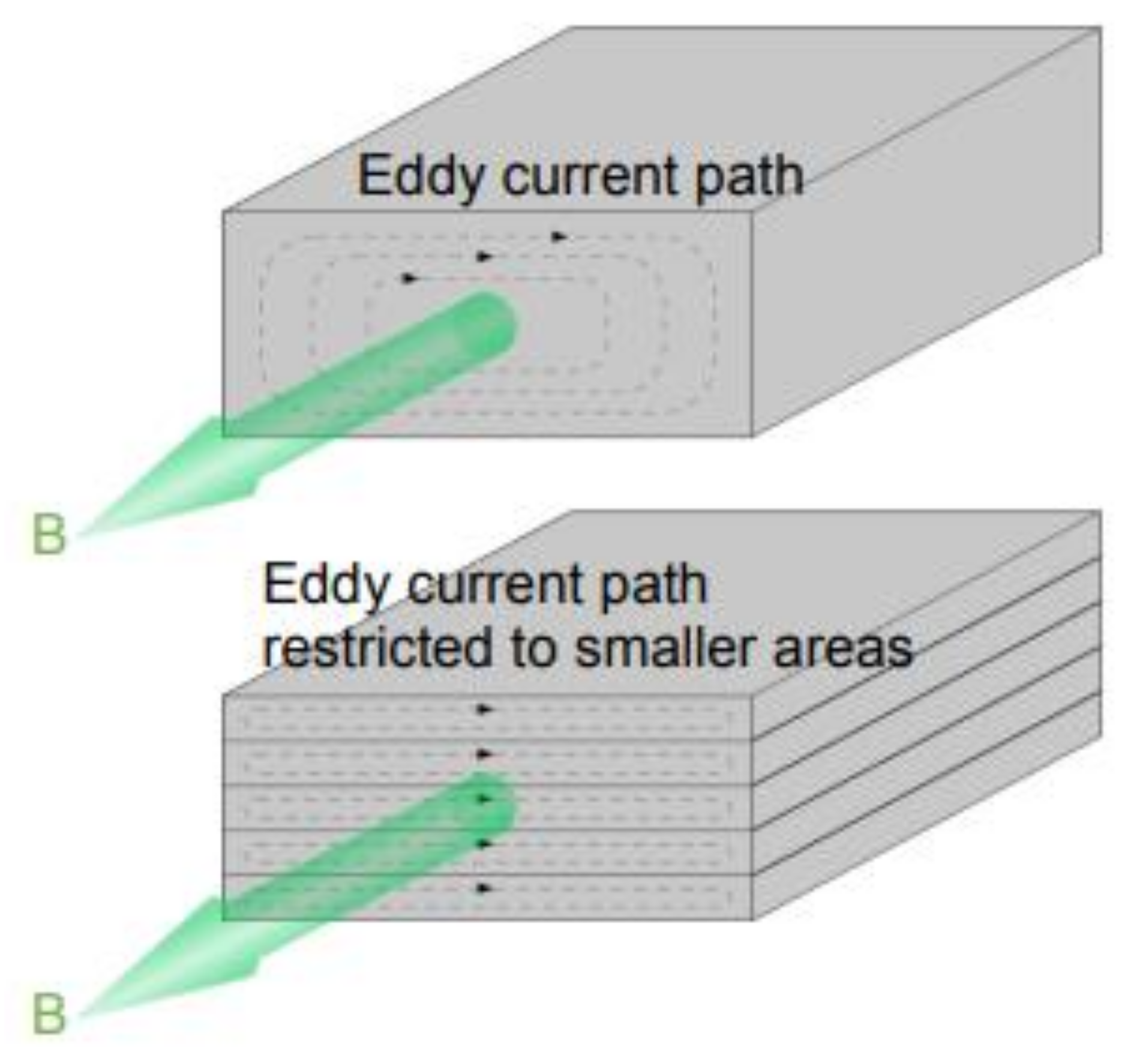
6.2.3. Anomalous Loss
7. Factors Affecting Loss for Electrical Steel
7.1. Grain Size
7.2. Impurity Content
7.3. Soft Magnetic Materials
7.4. Hard Magnetic Materials
7.4.1. Remanence
7.4.2. Coercive Field
7.5. Impact of Harmonics
8. The Effect of Alloying Elements on Electrical Steel
8.1. Effect of Aluminium
8.2. Effect of Silicon–Iron (Si Fe)
High-Silicon-Content Non-Oriented Si Fe
8.3. Effect of Cobalt–Iron (Co Fe)
8.4. Effect of Nickel–Iron (Ni Fe)
8.5. Effect of Manganese
8.6. Top of Form
Effect of Phosphorus
8.7. Effect of Chromium
8.8. Effect of Tin
9. The Production and Advancement of Electrical Steels
10. Influence of Coating on Electrical Steel
11. Conclusions
- Microstructure’s Impact on Magnetic Properties:
- 2.
- Efficiency Enhancement through Loss Analysis:
- 3.
- Alloying Elements’ Role in Magnetic Customization:
- 4.
- Coatings: Dual-function Enhancements:
12. Future Research Directions and Identifying Research Gaps
Author Contributions
Funding
Institutional Review Board Statement
Informed Consent Statement
Data Availability Statement
Acknowledgments
Conflicts of Interest
References
- Hayakawa, Y. Electrical Steels. Encycl. Mater. Met. Alloys 2021, 2, 208–213. [Google Scholar] [CrossRef]
- Du, Y.; O’Malley, R.J.; Buchely, M.F.; Kelly, P. Effect of rolling process on magnetic properties of Fe-3.3 wt% Si non-oriented electrical steel. Appl. Phys. A Mater. Sci. Process. 2022, 128, 765. [Google Scholar] [CrossRef]
- Herrmann, H.; Bucksch, H. Saturation Magnetization. In Dictionary Geotechnical Engineering/Wörterbuch GeoTechnik; Springer: Berlin/Heidelberg, Germany, 2014; p. 1170. [Google Scholar] [CrossRef]
- Walter, J.L. Secondary Recrystallization. Texturen Forsch. Prax. Textures Res. Pract. 1969, 227–251. [Google Scholar] [CrossRef]
- Verbeken, K.; Infante-Danzo, I.; Barros-Lorenzo, J.; Schneider, J.; Houbaert, Y. Innovative processing for improved electrical steel properties. Rev. Metal. 2010, 46, 458–468. [Google Scholar] [CrossRef]
- Gervasyeva, I.V.; Milyutin, V.A.; Mineyev, F.V.; Babushko, Y.Y. Assessment of the Textured State of the Nonoriented Electrical Steel for Electromobiles and the Effect of the Texture on the Basic Magnetic Characteristics. Phys. Met. Metallogr. 2020, 121, 618–623. [Google Scholar] [CrossRef]
- Coombs, A.; Lindenmo, M.; Snell, D.; Power, D. Review of the types, properties, advantages, and latest developments in insulating coatings on nonoriented electrical steels. IEEE Trans. Magn. 2001, 37, 544–557. [Google Scholar] [CrossRef]
- Ros-Yanez, T.; De Wulf, M.; Houbaert, Y. Influence of the Si and Al gradient on the magnetic properties of high-Si electrical steel produced by hot dipping and diffusion annealing. J. Magn. Magn. Mater. 2004, 272–276, 2003–2004. [Google Scholar] [CrossRef]
- Ren, Q.; Hu, Z.; Cheng, L.; Zhang, L. Effect of rare earth elements on magnetic properties of non-oriented electrical steels. J. Magn. Magn. Mater. 2022, 560, 169624. [Google Scholar] [CrossRef]
- Du, Y.; O’Malley, R.; Buchely, M.F. Review of Magnetic Properties and Texture Evolution in Non-Oriented Electrical Steels. Appl. Sci. 2023, 13, 6097. [Google Scholar] [CrossRef]
- Hong, J.; Choi, H.; Lee, S.; Kim, J.K.; Koo, Y.M. Effect of Al content on magnetic properties of Fe-Al Non-oriented electrical steel. J. Magn. Magn. Mater. 2017, 439, 343–348. [Google Scholar] [CrossRef]
- Ouyang, G.; Chen, X.; Liang, Y.; Macziewski, C.; Cui, J. Review of Fe-6.5 wt%Si high silicon steel—A promising soft magnetic material for sub-kHz application. J. Magn. Magn. Mater. 2019, 481, 234–250. [Google Scholar] [CrossRef]
- Shin, J.S.; Bae, J.S.; Kim, H.J.; Lee, H.M.; Lee, T.D.; Lavernia, E.J.; Lee, Z.H. Ordering-disordering phenomena and micro-hardness characteristics of B2 phase in Fe-(5–6.5%)Si alloys. Mater. Sci. Eng. A 2005, 407, 282–290. [Google Scholar] [CrossRef]
- Boehm, L.; Hartmann, C.; Gilch, I.; Stoecker, A.; Kawalla, R.; Wei, X.; Hirt, G.; Heller, M.; Korte-Kerzel, S.; Leuning, N.; et al. Grain size influence on the magnetic property deterioration of blanked non-oriented electrical steels. Materials 2021, 14, 7055. [Google Scholar] [CrossRef] [PubMed]
- Petryshynets, I.; Kováč, F.; Petrov, B.; Falat, L.; Puchý, V. Improving the magnetic properties of non-oriented electrical steels by secondary recrystallization using dynamic heating conditions. Materials 2019, 12, 1914. [Google Scholar] [CrossRef] [PubMed]
- Moses, A.J. Energy efficient electrical steels: Magnetic performance prediction and optimization. Scr. Mater. 2012, 67, 560–565. [Google Scholar] [CrossRef]
- Moses, T. Opportunities for exploitation of magnetic materials in an energy conscious world. Interdiscip. Sci. Rev. 2002, 27, 100–113. [Google Scholar] [CrossRef]
- Leuning, N.; Steentjes, S.; Hameyer, K. Effect of grain size and magnetic texture on iron-loss components in NO electrical steel at different frequencies. J. Magn. Magn. Mater. 2019, 469, 373–382. [Google Scholar] [CrossRef]
- Lee, H.H.; Jung, J.; Yoon, J.I.; Kim, J.K.; Kim, H.S. Modelling the evolution of recrystallization texture for a non-grain oriented electrical steel. Comput. Mater. Sci. 2018, 149, 57–64. [Google Scholar] [CrossRef]
- Goss, N.P. New Development in Electrical Strip Steels Characterized by Fine Grain Structure Approaching the Properties of a Single Crystal. Trans. Amer. Soc. Metals 1935, 23, 511–531. [Google Scholar]
- Yue-Lin, L.; Ying, Z.; Rong-Jie, H.; Guang-Hong, L. Study of the theoretical tensile strength of Fe by a first-principles computational tensile test. Chinese Phys. B 2009, 18, 1923–1930. [Google Scholar] [CrossRef]
- Ye, T.; Lu, Z.; Ma, C. Evolution of Microstructure and Texture with the Low-Silicon in Non-Oriented Silicon Steel. IOP Conf. Ser. Earth Environ. Sci. 2018, 170, 042086. [Google Scholar] [CrossRef]
- IEC 60404-2; Magnetic Materials—Part 2: Methods of Measurement of the Magnetic Properties of Electrical Steel Strip and Sheet by Means of an Epstein Frame. International Electrotechnical Commission: Geneva, Switzerland, 2008.
- Siovert, J.D. Determination of AC magnetic power loss of electrical steel sheet: Present status and trends. IEEE Trans. Magn. 1984, 20, 1702–1707. [Google Scholar] [CrossRef]
- Marketos, P.; Zurek, S.; Moses, A.J. Calculation of the mean path length of the Epstein frame under non-sinusoidal excitations using the double Epstein method. J. Magn. Magn. Mater. 2008, 320, 2542–2545. [Google Scholar] [CrossRef]
- Leuning, N.; Steentjes, S.; Stöcker, A.; Kawalla, R.; Wei, X.; Dierdorf, J.; Hirt, G.; Roggenbuck, S.; Korte-Kerzel, S.; Weiss, H.A.; et al. Impact of the interaction of material production and mechanical processing on the magnetic properties of non-oriented electrical steel. AIP Adv. 2018, 8, 047601. [Google Scholar] [CrossRef]
- Moses, A.J. Effects of stress on the magnetic properties of grain-oriented silicon-iron magnetized in various directions. IEEE Trans. Magn. 1981, 17, 2872–2874. [Google Scholar] [CrossRef]
- Ros-Yañez, T.; Houbaert, Y.; Gómez Rodríguez, V. High-silicon steel produced by hot dipping and diffusion annealing. J. Appl. Phys. 2002, 91, 7857–7859. [Google Scholar] [CrossRef]
- Lyudkovsky, G.; Rastogi, P.K.; Bala, M. Nonoriented Electrical Steels. JOM 1986, 38, 18–26. [Google Scholar] [CrossRef]
- Zhang, Y.; Cheng, M.C.; Pillay, P. A novel hysteresis core loss model for magnetic laminations. IEEE Trans. Energy Convers. 2011, 26, 993–999. [Google Scholar] [CrossRef]
- Chen, Y.; Pillay, P. An improved formula for lamination core loss calculations in machines operating with high frequency and high flux density excitation. In Proceedings of the Conference Record of the 2002 IEEE Industry Applications Conference, 37th IAS Annual Meeting (Cat. No.02CH37344), Pittsburgh, PA, USA, 13–18 October 2002; Volume 2, pp. 759–766. [Google Scholar] [CrossRef]
- Guru, B.S.; Hiziroglu, H.R. Electric Machinery and Transformers, 3rd ed.; Oxford University Press: New York, NY, USA, 2001; ISBN 9780195138900. [Google Scholar]
- Popovic, Z.B.; Popovic, B.D. Introductory Electromagnetics: Practice, Problems and Labs. 2000, p. 305. Available online: https://cdn.preterhuman.net/texts/science_and_technology/physics/Electromagnetic_Field_Theory/Introductory%20Electromagnetics%20-%20Z.%20Popovic,%20B.%20Popovic.pdf (accessed on 1 January 2022).
- Ibrahim, M.; Pillay, P. Advanced testing and modeling of magnetic materials including a new method of core loss separation for electrical machines. IEEE Trans. Ind. Appl. 2012, 48, 1507–1515. [Google Scholar] [CrossRef]
- Loss, W.; Oriented, G. Method for Producing a Super Low Watt Loss Grain Oriented Electrical STEEL Sheet. U.S. Patent No. 3,932,236, 13 January 1976. [Google Scholar]
- Yamamoto, T.; Nozawa, T. Effects of tensile stress on total loss of single crystals of 3% silicon-iron. J. Appl. Phys. 1970, 41, 2981–2984. [Google Scholar] [CrossRef]
- Goel, V.; Anderson, P.; Hall, J.; Robinson, F.; Bohm, S. Electroless Plating: A Versatile Technique to Deposit Coatings on Electrical Steel. IEEE Trans. Magn. 2016, 52, 8–11. [Google Scholar] [CrossRef]
- Moses, A.J.; Jiles, D.C. Origin, Measurement and Application of the Barkhausen Effect in Magnetic Steeltle. 2007. Available online: https://books.google.co.uk/books?hl=en&lr=&id=EmbmP6qPNxIC&oi=fnd&pg=PA4&dq=A.J.+Moses,+D.C.+Jiles,+in:+S.+Takahashi,+H.+Kikuchi+(Eds.),+Electromagnetic+Nondestructive+Evaluation,+IOS+Press,+2007,+p.+4.&ots=hGJbfUgUw5&sig=wk-DX6dBdgxqDLJ9obuJrO7lsZ8#v=one (accessed on 1 January 2022).
- Shilling, J.W.; Houze, G.L.; Moses, A.J.; Jiles, D.C. Electromagnetic Nondestructive Evaluation; Takahashi, S., Kikuchi, H., Eds.; IOS Press: Amsterdam, The Netherlands, 2007; p. 4. [Google Scholar]
- Calvillo, P.R. Deformation Analysis of High-Si-Steel during Torsion and Compression Testing. Ph.D. Thesis. 2007. Available online: http://hdl.handle.net/1854/LU-8598031%0A (accessed on 1 November 2022).
- Transactions, I. Magnetic properties and dynamic domain behavior in grain-oriented 3% Si-Fe(Article). IEEE Trans. Magn. 1996, 32, 572–589. [Google Scholar]
- Lewis, E.; Initiating, A.; Vii, S.; Halide, T.; Halide, Z.; Systems, I. High Electrical Resistivity and Permeability of Soft Magnetic Granular Alloys. Polymer 1991, 2, 10403–10411. [Google Scholar] [CrossRef]
- Moses, A.J. Electrical steels. Past, present and future developments. IEEE Proc. A Phys. Sci. Meas. Instrum. Manag. Educ. Rev. 1990, 137, 233–245. [Google Scholar] [CrossRef]
- Honda, O.; Kaya, S.; Masuyama, Y. On the magnetic properties of single crystals of iron. Nature 1926, 117, 753–754. [Google Scholar] [CrossRef]
- Wohlfarth, E.P.; Arrott, A.S. Ferromagnetic Materials: A Handbook on the Properties of Magnetically Ordered Substances, Vols. 1 and 2. Phys. Today 1982, 35, 63–64. [Google Scholar] [CrossRef]
- Gregersen, E. The Britannica Guide to Electricity and Magnetism; Firest: New York, NY, USA, 2011; Available online: https://books.google.co.uk/books?hl=en&lr=&id=ac2cAAAAQBAJ&oi=fnd&pg=PP1&ots=ijIcoJG992&sig=3t5HXFLBRqrRmlTdxn-HMEHRkig&redir_esc=y#v=onepage&q&f=false (accessed on 1 January 2023).
- Laughton, M.A.; Say, M.G. Electrical Engineer’s Reference Book, 4th ed.; Elsevier: Amsterdam, The Netherlands, 2013; ISBN 978-0-408-00431-2. [Google Scholar] [CrossRef]
- Oda, Y.; Okubo, T.; Takata, M. Recent development of non-oriented electrical steel in JFE steel. JFE Tech. Rep. 2016, 21, 7–13. [Google Scholar]
- Binesti, D.; Ducreux, J.P. Core losses and efficiency of electrical motors using new magnetic materials. IEEE Trans. Magn. 1996, 32, 4887–4889. [Google Scholar] [CrossRef]
- Zu, G.; Xu, Y.; Luo, L.; Han, Y.; Sun, S.; Miao, R.; Zhu, W.; Gao, L.; Ran, X. Effect of rolling temperature on the recrystallization behavior of 4.5 wt.% Si non-oriented electrical steel. J. Mater. Res. Technol. 2022, 17, 365–373. [Google Scholar] [CrossRef]
- Werner, F.E.; Jaffee, R.I. Energy-efficient steels for motor laminations. J. Mater. Eng. Perform. 1992, 1, 227–234. [Google Scholar] [CrossRef]
- Nakayama, T.; Honjou, N.; Nagai, A.; Yashiki, H. Non-oriented electrical steel sheets. Sumitomo Met. 1996, 48, 39–44. [Google Scholar]
- Hawezy, D. The influence of silicon content on physical properties of non-oriented silicon steel. Mater. Sci. Technol. 2017, 33, 1560–1569. [Google Scholar] [CrossRef]
- ASTM A976-18; Standard Classification of Insulating Coatings for Electrical Steels by Composition, Relative Insulating Ability and Application. ASTM International: West Conshohocken, PA, USA, 2013.
- Shrivastava, K.N. Flux Quantization; Springer: Dordrecht, The Netherlands, 2000; ISBN 978-94-011-7008-6. [Google Scholar]
- Tang, Q. Investigation of Magnetic Properties of Electrical Steel and Transformer Core at High Flux Densities; The University of Manchester: Manchester, UK, 2015; p. 92. [Google Scholar]
- Dey, P.K. Application of Ferrite Medium in Microwave Devices. In Proceedings of the 60th CONGRESS ISTAM Section Code: SM8, Jaipur, India, 16–19 December 2015. [Google Scholar]
- Heathcote, M. J & P Transformer Book, 13th ed.; Elsevier: Amsterdam, The Netherlands; London, UK; Oxford, UK, 2011; Available online: https://books.google.co.uk/books?op=lookup&id=paPKsOXn5FMC&continue=https://books.google.co.uk/books%3Fhl%3Den%26lr%3D%26id%3DpaPKsOXn5FMC%26oi%3Dfnd%26pg%3DPP1%26dq%3DM.%2BJ.%2BHeathcote,%2BThe%2BJ%2B%2526%2BP%2Btransformer%2Bbook%2B:%2Ba%2Bpractical%2Bt (accessed on 1 January 2023).
- Cullity, B.D.; Graham, C.D. Introduction to Magnetic Magnetic Materials, 2nd ed.; IEEE Pres&Wiley: Hoboken, NJ, USA, 2009; p. 322. [Google Scholar]
- Brailsford, F.; Burgess, J.M. Internal waveform distortion in silicon-iron laminations for magnetization at 50 c/s. Proc. IEEE Part C Monogr. 1961, 108, 458. [Google Scholar] [CrossRef]
- Agarwal, P.D.; Rabins, L. Rigorous Solution of Eddy Current Losses in Rectangular Bar for Single Plane Domain Wall Model. J. Appl. Phys. 2009, 31, S246–S248. [Google Scholar] [CrossRef]
- Kwun, H.; Burkhardt, G.L. Effects of grain size, hardness, and stress on the magnetic hysteresis loops of ferromagnetic steels. J. Appl. Phys. 1987, 61, 1576–1579. [Google Scholar] [CrossRef]
- Rezayat, M.; Karamimoghadam, M.; Moradi, M.; Casalino, G.; Roa Rovira, J.J.; Mateo, A. Overview of Surface Modification Strategies for Improving the Properties of Metastable Austenitic Stainless Steels. Metals 2023, 13, 1268. [Google Scholar] [CrossRef]
- Liu, J.; Wilson, J.; Davis, C.L.; Peyton, A. Magnetic characterisation of grain size and precipitate distribution by major and minor BH loop measurements. J. Magn. Magn. Mater. 2019, 481, 55–67. [Google Scholar] [CrossRef]
- Eisen, R. Fe–Si Iron–Silicon; Springer: Berlin/Heidelberg, Germany, 1982. [Google Scholar]
- Gorji Ghalamestani, S.; Vandevelde, L.; Dirckx, J.J.J.; Melkebeek, J.A.A. Magnetostriction and the influence of higher harmonics in the magnetic field. IEEE Trans. Magn. 2012, 48, 3981–3984. [Google Scholar] [CrossRef]
- Moses, A.J. Effects of magnetic properties and geometry on flux harmonics and losses in 3-phase, 5-limb, split-limb, transformer cores. IEEE Trans. Magn. 1987, 23, 3780–3782. [Google Scholar] [CrossRef]
- Yoshida, T.; Bai, S.; Hirokawa, A.; Tanabe, K.; Enpuku, K. Effect of viscosity on harmonic signals from magnetic fluid. J. Magn. Magn. Mater. 2015, 380, 105–110. [Google Scholar] [CrossRef]
- TAGUCHI, S. Review of the Recent Development of Electrical Sheet Steel. Tetsu-to-Hagane 1976, 62, 905–915. [Google Scholar] [CrossRef] [PubMed]
- Moses, A.J.; Thursby, G.J. Assessment of a novel method of improving the characteristics of electrical steels by a surface diffusion technique. J. Mater. Sci. 1983, 18, 1650–1656. [Google Scholar] [CrossRef]
- Anayi, F.; Moses, A.J.; Jenkins, K. Effect of aluminium diffusion into electrical steel on power loss under flux distortion conditions. J. Magn. Magn. Mater. 2003, 254–255, 36–38. [Google Scholar] [CrossRef]
- Ros-Yáñez, T.; Ruiz, D.; Barros, J.; Houbaert, Y. Advances in the production of high-silicon electrical steel by thermomechanical processing and by immersion and diffusion annealing. J. Alloys Compd. 2004, 369, 125–130. [Google Scholar] [CrossRef]
- Calvillo, P.R.; Bernárdez, P.; Houbaert, Y. Production of electrical steel by hot dipping in aluminium. Defect Diffus. Forum 2008, 273–276, 63–68. [Google Scholar] [CrossRef]
- Marques Marra, K.; Carneiro Marra, L.; Tadeu Lopes Buono, V. Effect of Aluminium Addition on the Magnetic Properties of a Semi-Processed Electrical Steel. Mater. Res. 2016, 19, 1162–1166. [Google Scholar] [CrossRef][Green Version]
- Chwastek, K.; Wodzyński, A.; Baghel, A.P.S.; Kulkarni, S.V. Anisotropic properties of electrical steels. In Proceedings of the 2015 16th International Conference on Computational Problems of Electrical Engineering (CPEE), Lviv, Ukraine, 2–5 September 2015; pp. 21–23. [Google Scholar] [CrossRef]
- Senda, K.; Uesaka, M.; Yoshizaki, S.; Oda, Y. Electrical steels and their evaluation for automobile motors. World Electr. Veh. J. 2019, 10, 31. [Google Scholar] [CrossRef]
- Felix, R.; Cardoso, D.A.; Brandao, L.; Antônio, M.; De Pesquisa, C.; Acesita, S.A.; Mg, T. Influence of Grain Size and Additions of Al and Mn on the Magnetic Properties of Non-Oriented Electrical Steels with 3 wt. (%) Si 3. Mater. Res. 2008, 11, 51–55. [Google Scholar]
- Anon Electrical Steel Sheets. Nippon Steel Tech. Rep. 1983, 127–134.
- Rodewald, R.H.W. Magnetic Materials: Fundamentals, Products, Properties, Applications; Publicis: Erlangen, Germany; VAC, VACUUMSCHMELZE: Hanau, Germany, 2013. [Google Scholar]
- Gmbh, V.; Data, R.U.S.A.; Application, F.; Data, P. Electric Motor for Use Ina Sterilizable Dental Handpiece. U.S. Patent 8,487,488, 16 July 2013. [Google Scholar]
- Krings, A.; Boglietti, A.; Cavagnino, A.; Sprague, S. Soft Magnetic Material Status and Trends in Electric Machines. IEEE Trans. Ind. Electron. 2017, 64, 2405–2414. [Google Scholar] [CrossRef]
- Cossale, M.; Krings, A.; Soulard, J.; Boglietti, A.; Cavagnino, A. Practical Investigations on Cobalt-Iron Laminations for Electrical Machines. IEEE Trans. Ind. Appl. 2015, 51, 2933–2939. [Google Scholar] [CrossRef]
- ACUUMSCHMELZE GmbH & Co. KG, H. Soft Magnetic Materials and Semi-Finished Products Soft Magnetic Materials and Semi-Finished Products Contents Main Headings: 2002. Available online: https://vacuumschmelze.com/03_Documents/Brochures/PHT%20001%20en.pdf (accessed on 1 January 2023).
- Spaldin, N.A. Magnetic Materials. Available online: https://www.google.co.uk/books/edition/Magnetic_Materials/vnrOE8pQUgIC?hl=en&gbpv=1&dq=Material+developments.+Magn.+Technol.+Int.+16%E2%80%9319+.&pg=PR7&printsec=frontcover (accessed on 1 January 2023).
- Rastogi, P.K. Effect of manganese and sulfur on the texture and magnetic properties of non-oriented steel. IEEE Trans. Magn. 1977, 13, 1448–1450. [Google Scholar] [CrossRef]
- Liao, K.C. The effect of manganese and sulfur contents on the magnetic properties of cold rolled lamination steels. Metall. Trans. A 1986, 17, 1259–1266. [Google Scholar] [CrossRef]
- Yashiki, H.; Kaneko, T. Effects of Mn and S on the Grain Growth and Texture in Cold Rolled 0.5% Si Steel. ISIJ Int. 1990, 30, 325–330. [Google Scholar] [CrossRef]
- Kubota, T. Recent Progress on Non-oriented Silicon Steel. J. Chem. Inf. Model. 2005, 76, 1689–1699. [Google Scholar] [CrossRef]
- Nakayama, T.; Honjou, N.; Minaga, T.; Yashiki, H. Effects of manganese and sulfur contents and slab reheating temperatures on the magnetic properties of non-oriented semi-processed electrical steel sheet. J. Magn. Magn. Mater. 2001, 234, 55–61. [Google Scholar] [CrossRef]
- Ghosh, P.; Chromik, R.R.; Knight, A.M.; Wakade, S.G. Effect of metallurgical factors on the bulk magnetic properties of non-oriented electrical steels. J. Magn. Magn. Mater. 2014, 356, 42–51. [Google Scholar] [CrossRef]
- Schulte, M.; Steentjes, S.; Leuning, N.; Bleck, W.; Hameyer, K. Effect of manganese in high silicon alloyed non-oriented electrical steel sheets. J. Magn. Magn. Mater. 2019, 477, 372–381. [Google Scholar] [CrossRef]
- Tanaka, I.; Yashiki, H. Magnetic properties and recrystallization texture evolutions of phosphorus-bearing non-oriented electrical steel sheets. ISIJ Int. 2007, 47, 1666–1671. [Google Scholar] [CrossRef][Green Version]
- Elgamli, E.; Anayi, F.; Shouran, M. Impact of manganese diffusion into non-oriented electrical steel on power loss and permeability at different temperatures. Front. Mater. 2023, 9, 1108308. [Google Scholar] [CrossRef]
- Komatsubara, M.; Sadahiro, K.; Kondo, O.; Takamiya, T.; Honda, A. Newly developed electrical steel for high-frequency use. J. Magn. Magn. Mater. 2002, 242–245, 212–215. [Google Scholar] [CrossRef]
- Dong, H.; Zhao, Y.; Yu, X.; Lian, F.Z. Effects of Sn Addition on Core Loss and Texture of Non-Oriented Electrical Steels. J. Iron Steel Res. Int. 2009, 16, 86–89. [Google Scholar] [CrossRef]
- Mathematics, A. Recent Progress on Non-oriented Silicon Steel. Steel Res. Int. 2016, 76, 1–23. [Google Scholar]
- Nagasaki, C.; Kihara, J. Effect of copper and tin on hot ductility of ultra-low and 0.2% carbon steels. ISIJ Int. 1997, 37, 523–530. [Google Scholar] [CrossRef]
- Matsuoka, H.; Osawa, K.; Ono, M.; Ohmura, M. Influence of Cu and Sn on Hot Ductility of Steels with Various C Content. ISIJ Int. 1997, 37, 255–262. [Google Scholar] [CrossRef]
- Loisos, G.; Moses, A.J.; Beckley, P. Electrical stress on electrical steel coatings. J. Magn. Magn. Mater. 2003, 254–255, 340–342. [Google Scholar] [CrossRef]
- Couderchon, G.; Brissonneau, P. Magnetic Properties of Goss-Textured Si-Fe Sheets with the Addition of Al. IEEE Trans. Magn. 1974, 10, 170–172. [Google Scholar] [CrossRef]
- Calvillo, P.R.; Suarez, L.; Houbaert, Y. Al-Si-Fe intermetallics on Fe-substrates during hot-dipping. Defect Diffus. Forum 2010, 297–301, 1042–1047. [Google Scholar] [CrossRef]
- Major, R.V.; Orrock, C.M. High saturation ternary cobalt-iron based alloys. IEEE Trans. Games 1988, 11, C2. [Google Scholar] [CrossRef]
- Yu, R.H.; Basu, S.; Ren, L.; Zhang, Y.; Parvizi-Majidi, A.; Unruh, K.M.; Xiao, J.Q. High temperature soft magnetic materials: FeCO alloys and composites. IEEE Trans. Magn. 2000, 36, 3388–3393. [Google Scholar] [CrossRef]
- Honma, K.; Nozawa, T.; Kobayashi, H.; Shimoyama, Y.; Tachino, I.; Miyoshi, K. Development of non-oriented and grain-oriented silicon steel (invited). IEEE Trans. Magn. 1985, 21, 1903–1908. [Google Scholar] [CrossRef]
- Yamaguchi, H.; Muraki, M.; Komatsubara, M. Application of CVD method on grain-oriented electrical steel. Surf. Coat. Technol. 2006, 200, 3351–3354. [Google Scholar] [CrossRef]
- Nishiike, U.; Kan, T.; Honda, A. Influence of Surface Properties on the Stress Magnetization Properties of Grain-oriented Silicon Steel. IEEE Transl. J. Magn. Japan 1993, 8, 777–782. [Google Scholar] [CrossRef]
- De Araujo Cardoso, R.F.; Da Cunha, M.A.; Brandão, L.P.M. Optimization of the magnetic losses of electrical steels through addition of Al and Si using a hot dipping process. J. Mater. Res. Technol. 2013, 2, 276–281. [Google Scholar] [CrossRef][Green Version]



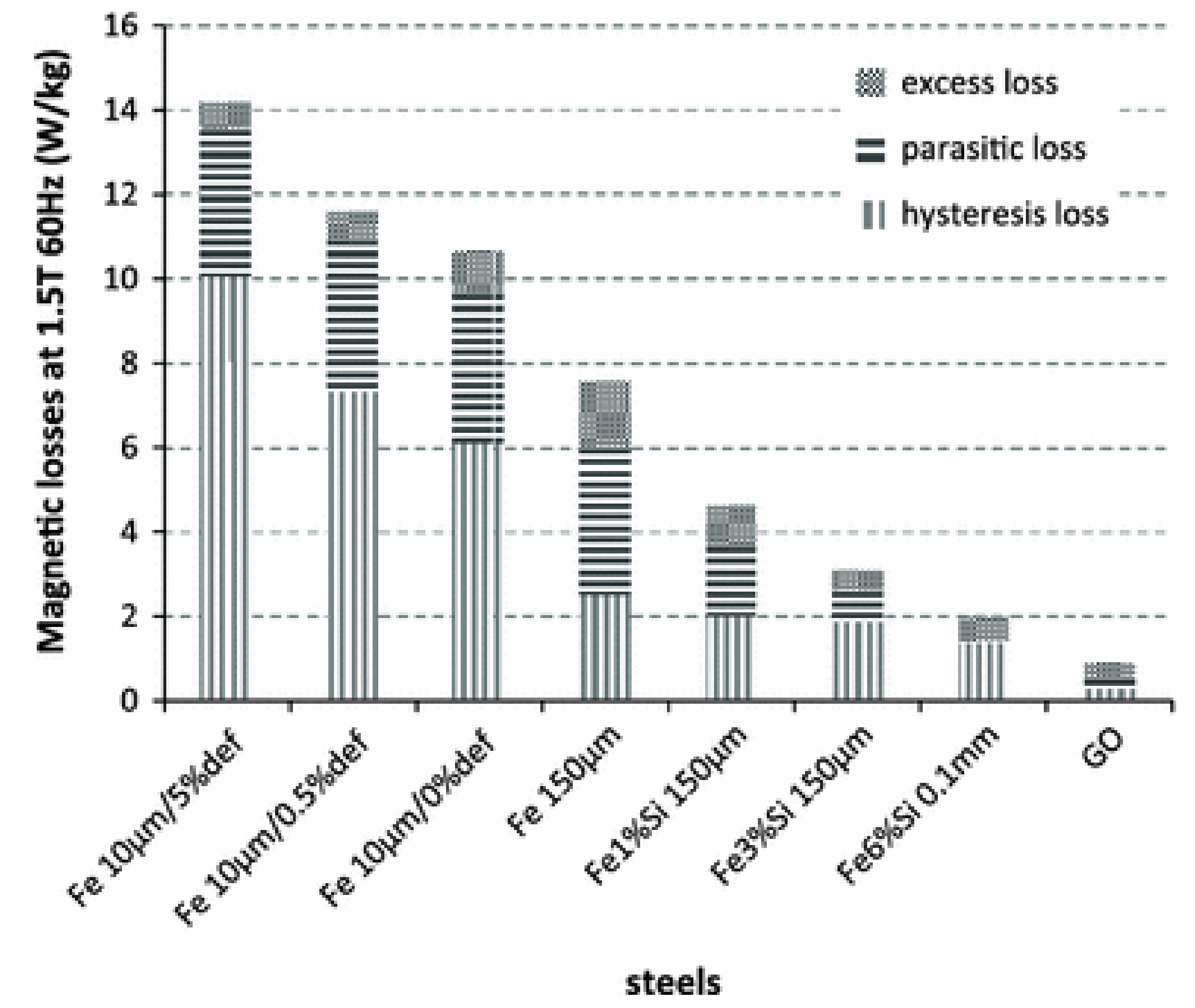


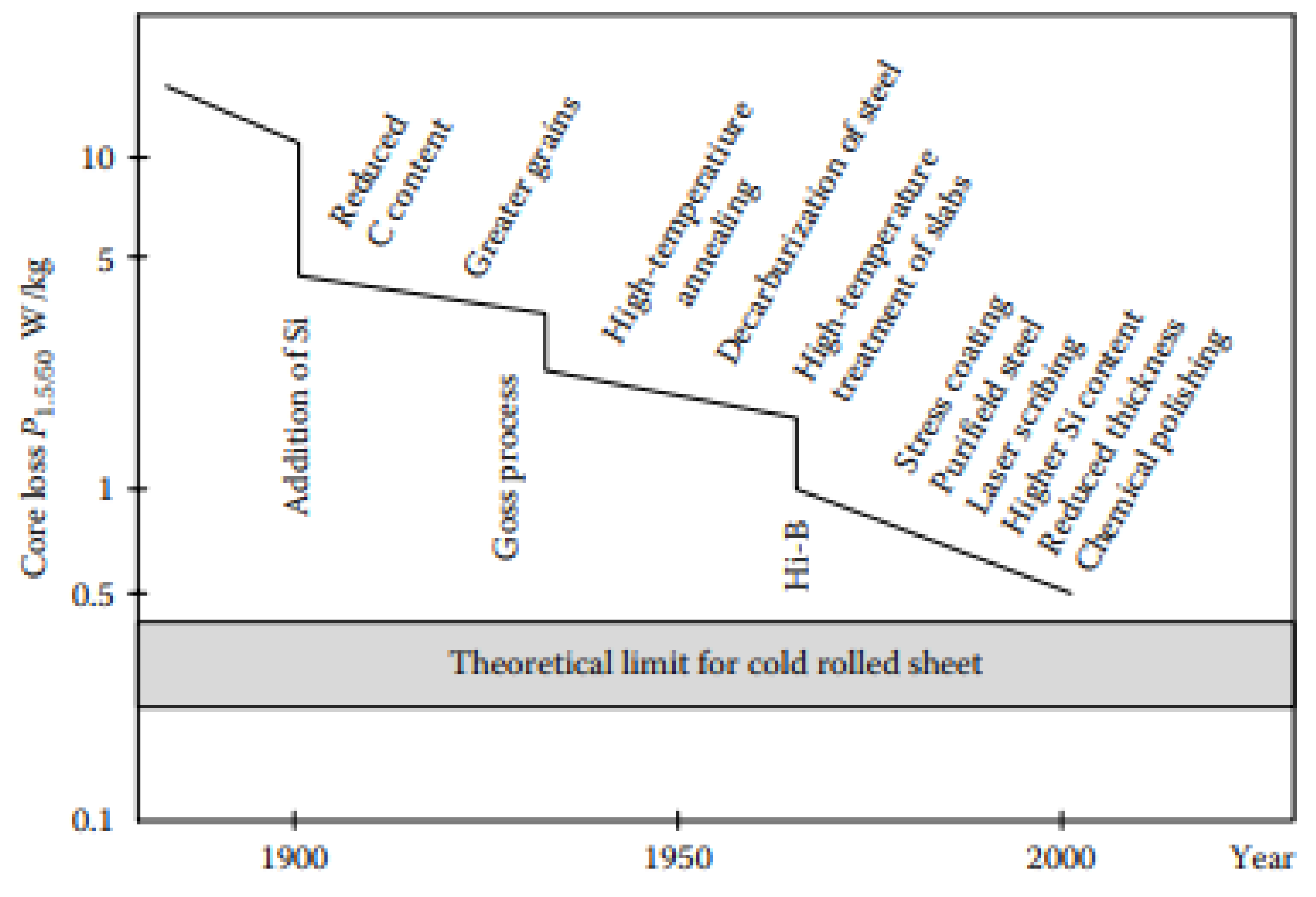
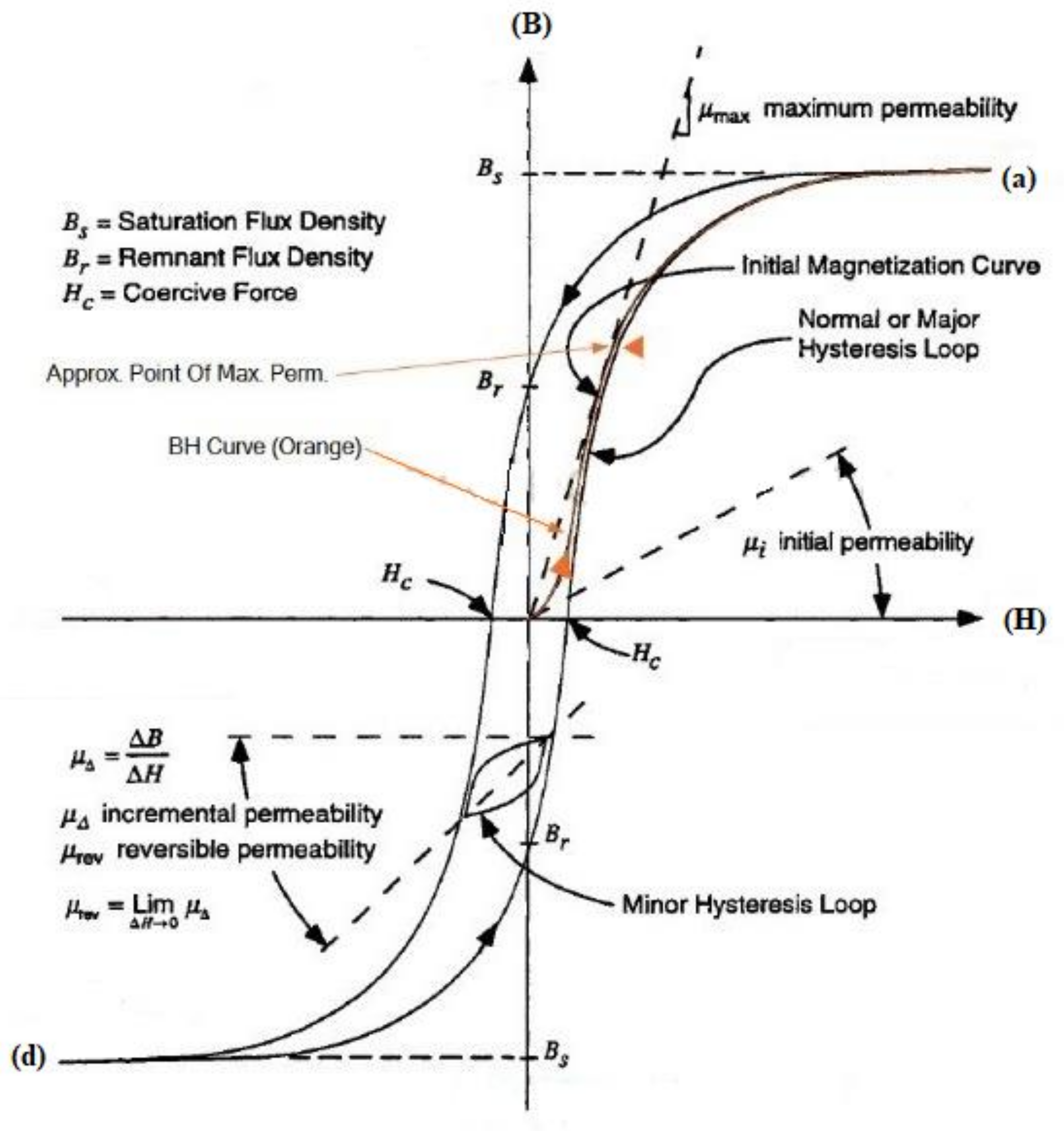
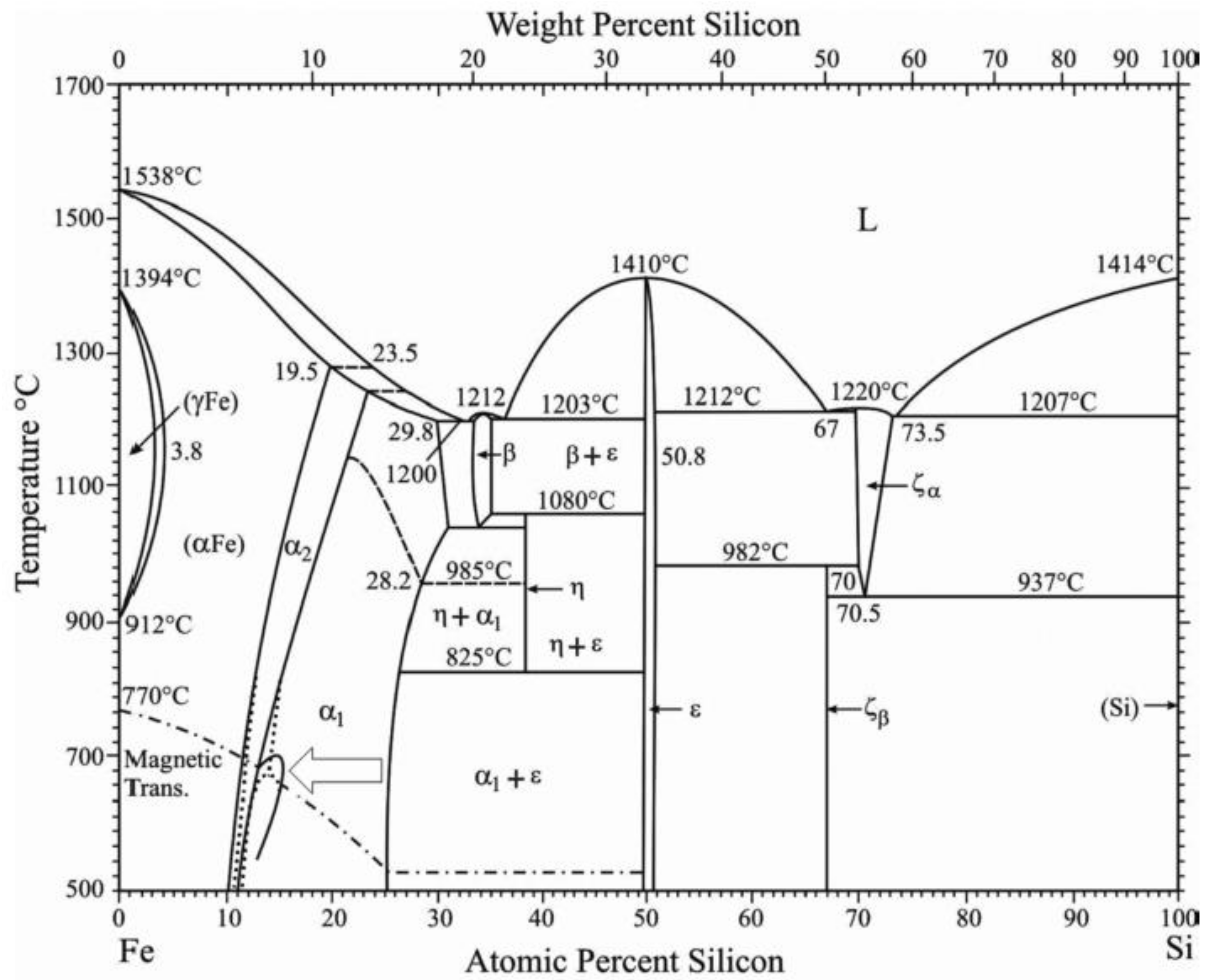
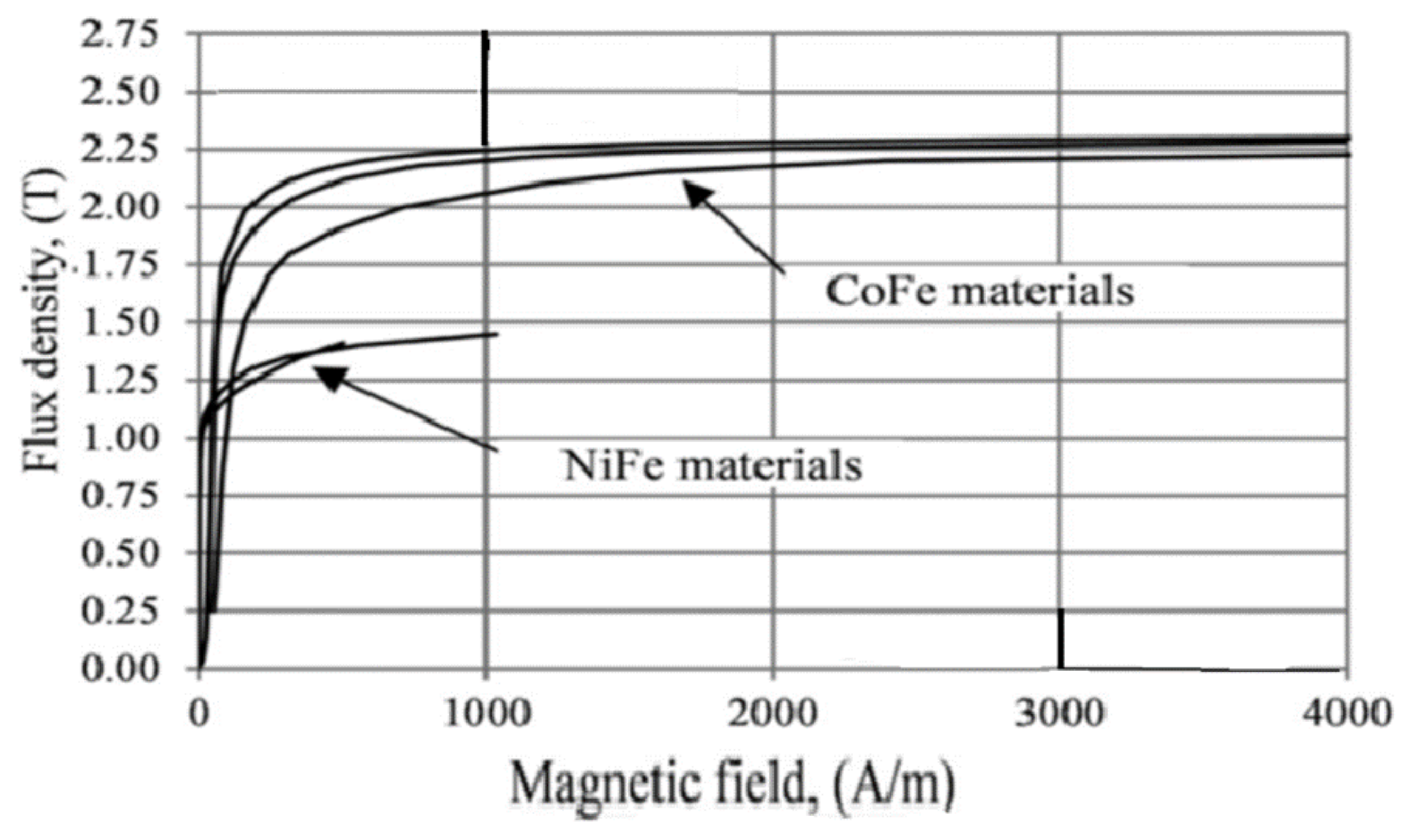

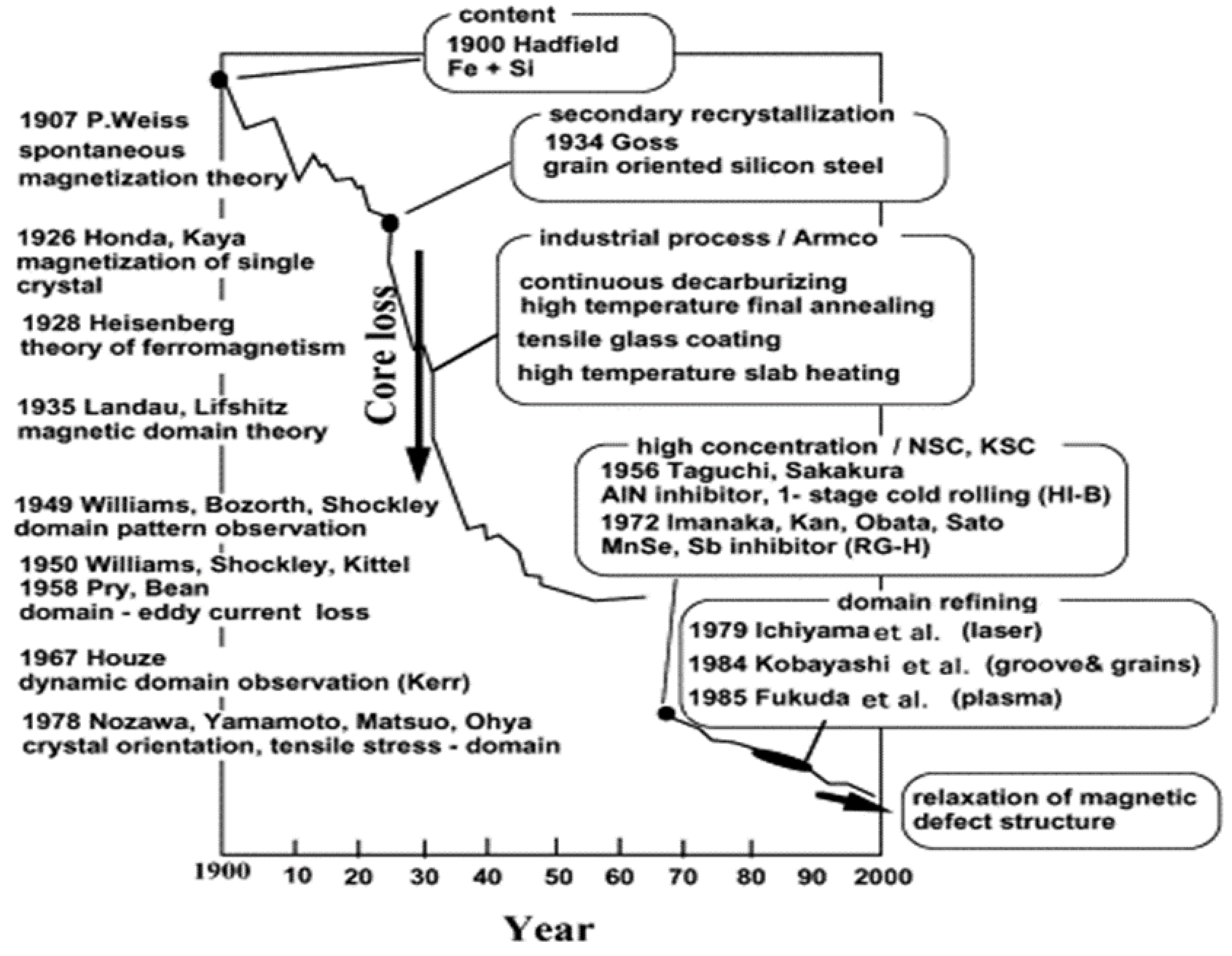
| Frequency (Hz) | Material Specification | Hysteresis Loss (Ph) | Eddy Current Loss (Pe) | Excess Loss (Pexc) |
|---|---|---|---|---|
| 50 | Low silicon | 30–50 | 40–60 | 0–20 |
| High silicon | 55–75 | 20–30 | 10–20 | |
| Thin high Si | 80–90 | 1–2 | 5–15 | |
| 100 | Low silicon | 20–30 | 50–70 | 10–20 |
| High silicon | 25–35 | 40–60 | 15–25 | |
| Thin high Si | 80–90 | 1–2 | 5–15 |
| Element | Effect on Properties | Benefits | Drawbacks |
|---|---|---|---|
| Aluminium | Increased resistance. | Reduced energy loss in appliances. | Brittle steel, processing challenges. |
| Silicon | Reduced permeability. | Narrowed magnetic properties. | Increased resistance, processing challenges. |
| Manganese | Increased resistance. | Reduced losses, improved permeability. | Smaller grains, deterioration in some cases. |
| Cobalt | Enhanced magnetization. | Improved magnetic properties. | Higher cost, complex material composition. |
| Nickel | Increased permeability. | Low losses for specific applications. | Greater eddy current losses, conductivity. |
| Phosphorus | Variable impact. | Enhanced or reduced induction, texture change. | Influence on texture, induction variation. |
| Chromium | Reduction in bead size. | Improved microstructure, desired phase. | Minimal impact on magnetic properties. |
| Tin | Improved crystalline texture. | Reduced core loss, increased flux density. | Excessive addition may increase core loss |
| Others | Variable effects. | Various improvements and drawbacks. | Element-specific effects and trade-offs. |
Disclaimer/Publisher’s Note: The statements, opinions and data contained in all publications are solely those of the individual author(s) and contributor(s) and not of MDPI and/or the editor(s). MDPI and/or the editor(s) disclaim responsibility for any injury to people or property resulting from any ideas, methods, instructions or products referred to in the content. |
© 2023 by the authors. Licensee MDPI, Basel, Switzerland. This article is an open access article distributed under the terms and conditions of the Creative Commons Attribution (CC BY) license (https://creativecommons.org/licenses/by/4.0/).
Share and Cite
Elgamli, E.; Anayi, F. Advancements in Electrical Steels: A Comprehensive Review of Microstructure, Loss Analysis, Magnetic Properties, Alloying Elements, and the Influence of Coatings. Appl. Sci. 2023, 13, 10283. https://doi.org/10.3390/app131810283
Elgamli E, Anayi F. Advancements in Electrical Steels: A Comprehensive Review of Microstructure, Loss Analysis, Magnetic Properties, Alloying Elements, and the Influence of Coatings. Applied Sciences. 2023; 13(18):10283. https://doi.org/10.3390/app131810283
Chicago/Turabian StyleElgamli, Elmazeg, and Fatih Anayi. 2023. "Advancements in Electrical Steels: A Comprehensive Review of Microstructure, Loss Analysis, Magnetic Properties, Alloying Elements, and the Influence of Coatings" Applied Sciences 13, no. 18: 10283. https://doi.org/10.3390/app131810283
APA StyleElgamli, E., & Anayi, F. (2023). Advancements in Electrical Steels: A Comprehensive Review of Microstructure, Loss Analysis, Magnetic Properties, Alloying Elements, and the Influence of Coatings. Applied Sciences, 13(18), 10283. https://doi.org/10.3390/app131810283





